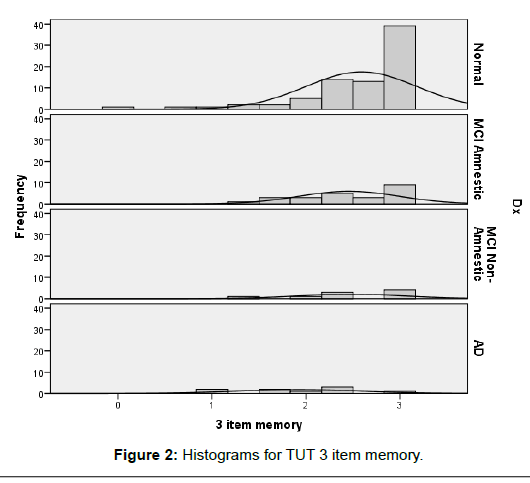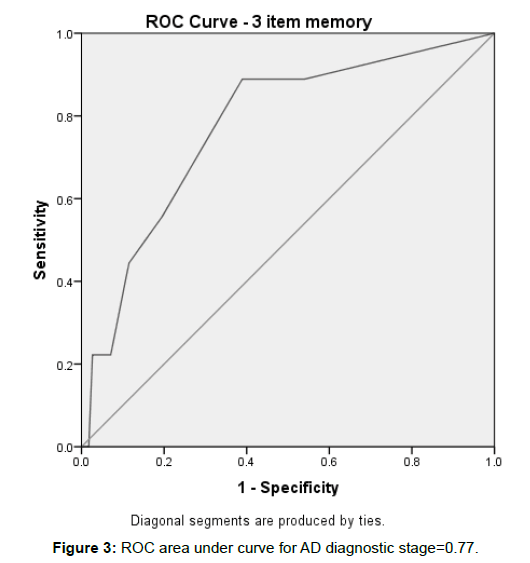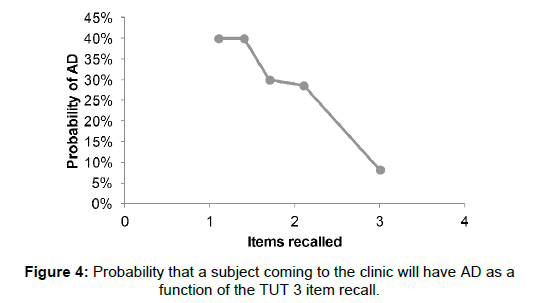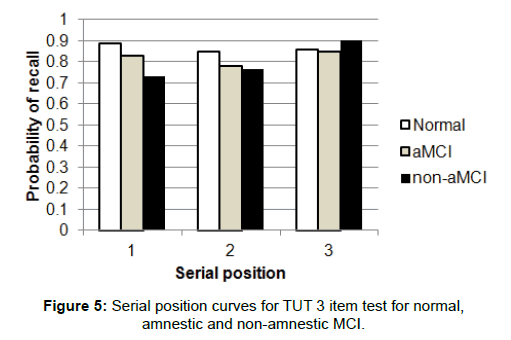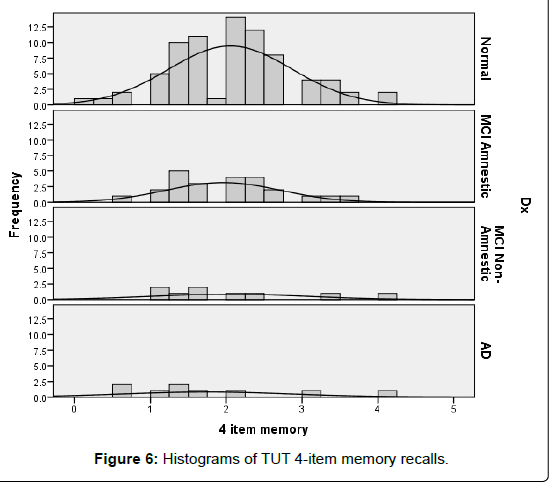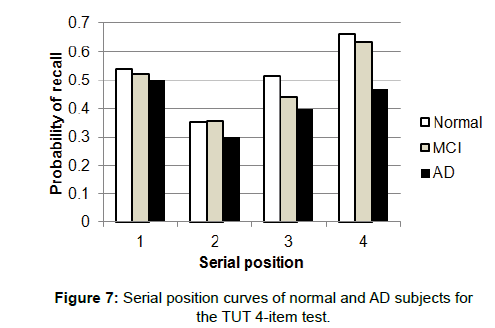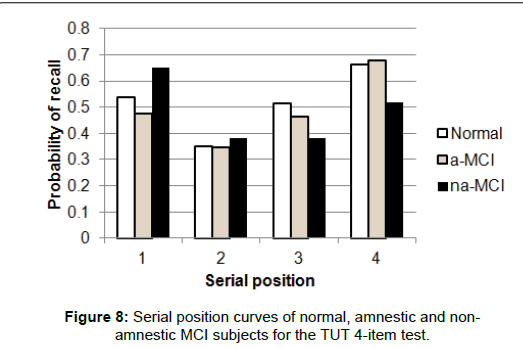Research Article Open Access
Preliminary Evidence: Diagnosed Alzheimer's Disease but not MCI Affects Working Memory: 0.6 of 2.6 Memory Pointers Lost
Eugen Tarnow*
Avalon Business Systems, 19-03 Maple Avenue, Fair Lawn, NJ 07410, USA
- *Corresponding Author:
- Eugen Tarnow
Data Scientist and Director of Consulting
Avalon Business Systems, 19-03 Maple Avenue
Fair Lawn, NJ 07410, USA
Tel: 1 646 825 9080
E-mail: etarnow@avabiz.com
Received date: March 09, 2017; Accepted date: March 22, 2017; Published date: March 29, 2017
Citation: Tarnow E (2017) Preliminary Evidence: Diagnosed Alzheimer’s Disease but not MCI Affects Working Memory: 0.6 of 2.6 Memory Pointers Lost. J Alzheimers Dis Parkinsonism 7:315. doi:10.4172/2161-0460.1000315
Copyright: © 2017 Tarnow E. This is an open-access article distributed under the terms of the Creative Commons Attribution License, which permits unrestricted use, distribution, and reproduction in any medium, provided the original author and source are credited.
Visit for more related articles at Journal of Alzheimers Disease & Parkinsonism
Abstract
Objective: Recently it was shown that free recall consists of two stages: the first few recalls empty working memory and a second stage, a reactivation stage, concludes the recall. It was also shown that the serial position curve changes in mild Alzheimer’s disease – lowered total recall and lessened primacy - are similar to second stage recall and different from recall from working memory. Here we wanted to investigate whether there were any free recall first stage changes in more advanced Alzheimer’s disease. Methods: The Tarnow Unchunkable Test (TUT) uses double integer items to separate out only the first stage, the emptying of working memory, by making it difficult to reactivate items due to the lack of intra-item relationships. Results: TUT is found to be gender and culture independent with small dependencies on age and years of education. TUT 3-item test selects out diagnosed Alzheimer’s disease but not amnestic MCI or non-amnestic MCI. On average, diagnosed Alzheimer’s disease is correlated with a loss of 0.6 memory pointers (out of an average of 2.6 pointers) and this is most pronounced for the later serial positions. Conclusion: Diagnosed Alzheimer’s disease is correlated with a loss of 0.6 working memory pointers. The identification of a lost memory pointer may have implications for improved stage definitions of Alzheimer’s disease and for remediation therapy via working memory capacity management.
Keywords
Alzheimer’s disease; Free recall; Working memory; Short term memory; Chunking; Serial position curve
Introduction
Free recall, in which items in a list are displayed or read to subjects who are then asked to retrieve the items, is one of the simplest ways to probe short term memory. It is used in neuropsychological batteries to test for the presence of Alzheimer’s disease, for example, MMSE, ADAS-Cog, FREES, CVLT, DWR, etc. [1-5]. The corresponding serial position curve, the probability of recalling an item versus the order in which the item was presented, is u-shaped: items in the beginning of the presented list (primacy) and at the end of the list (recency) are more likely to be recalled than those in the middle of the list.
It was recently shown explicitly that free recall is a well-defined two stage process [1,6]. In the first stage working memory is emptied. In the second stage a different retrieval process occurs in which items are reactivated. Working memory is responsible for recency (and some primacy for short lists) and the second stage recall shows some primacy but no recency [7]. Found that a reduction in the primacy effect is an early and ubiquitous feature of the memory impairment of AD and Tarnow [3] showed that early Alzheimer’s disease correlates with a loss of items from the second stage. (As an aside, because this loss is very similar to the loss during acute cannabis usage, the intersection of the two presumably localizes the second stage of free recall to the CA1 area of the hippocampus.) In this contribution we explore what happens to the first stage of free recall in amnestic MCI, non-amnestic MCI and diagnosed Alzheimer’s disease.
Our tool is the Tarnow Unchunkable Test (TUT), a free recall test in which the items are constructed to be unchunkable. The items are double digit integers and presumably language independent. Three or four items are read to the subject by a nurse and the subject is asked to recall the items immediately.
It is known that for Russian college students, the average TUT capacity is somewhat less than three items [8], that the items are accessed via pointers [9], that the four item result has a large dependency upon the field of study and the three item result has a medium field dependency [10], there is a small gender difference in the four item result but not in the three item result [11], there is directional learning in the three item test but not in the four item test [12] and that the capacity is limited both by interference and by errors that increase linearly with time elapsed since the last item presentation [13]. In fact, it may be the single most analyzed memory test on the market.
The symptoms necessary for a diagnosis of Alzheimer’s disease include “memory impairment”. A memory test has to be performed for the diagnosis to be given which presents a circular dilemma: if the diagnosis is given on the basis of a memory test, how can a memory test then evaluate the symptoms of the disease? Perhaps it just evaluates the first memory test?
One way is to dissect the very test used to diagnose Alzheimer’s disease. Previous studies of the cognitive components of Alzheimer’s disease examined the progress of the disease via a study of which items in the Mini-Mental State Exam (MMSW) fail and when they fail [14,15]. Ashford [14] reports that overall, the MMSE is the most sensitive 5 years after diagnosis and that at the time of diagnosis, multiple items fail a little – in other words some items are more sensitive to the stage at which an Alzheimer’s diagnosis is given but the differences are not great. This item response analysis allows for a better stage description but it only is as good as the items themselves. For example, the three item free recall test in the MMSE consists of items that can be chunked together; if a subject succeeds in such a chunking, the working memory capacity is overestimated.
Another way out of this dilemma is to create cognitive tests that are better defined than previous cognitive tests and hone in a particular cognitive component. TUT is such a test: it limits itself to the working memory content (the first stage of free recall) and does not allow for associations (the second stage of free recall) and also does not need any manipulation performed on the working memory content.
In this contribution we will examine whether the working memory capacity, as measured by the TUT, changes between normal, MCI and Alzheimer’s disease subjects. This research may have implications for improved stage definitions of Alzheimer’s disease and for remediation therapy via working memory capacity management.
Methods
Subjects
Participants were part of a clinical study for aging and dementia at the Alzheimer’s Disease Research Center at Icahn School of Medicine at Mount Sinai (ADRC ISMMS). Inclusion criteria included 65 years of age or older, primarily English/Chinese/Spanish speaking, visual and auditory acuity adequate for cognitive testing, willingness to participate in all clinical assessment, and having a study partner available as an informant. The demographics are displayed in Table 1.
Study procedure
All participants were asked to complete a 3-hour in-person dementia evaluation, which consisted of recording of demographic information, clinical interview, cognitive evaluation, medical examination and functional assessment. Upon completion of the evaluation, all participants were assigned a research diagnosis of normal cognition, Mild Cognitive Impairment (MCI) and dementia using Clinical Research Diagnostic Criteria employed at the ADRC ISMMS. The study was approved by the institutional board of the ISMMS. All participants provided signed informed consent.
Records indicating dementia due to oncology treatment and due to vascular dementia were discarded as was a record of a subject who refused to answer more than once.
The Tarnow Unchunkable Test [4] attempts to separate out just the first stage of free recall which empties working memory. It uses particular double-digit combinations which lack intra-item relationships, minimizing inter-item associative strengths [16], so that the second reactivation stage does not occur. The TUT is copyrighted and patent pending and can be purchased from Tarnow. It consists of 3-item tests and 4-item tests and can be done using paper, as was the case in this article, or by computer. It has been used on 500 Russian college students [8,9].
IBM SPSS Modeler was used to calculate correlations, ANOVA and regressions.
Results
The main results will center on the TUT 3 item memory score (other results appear in the Appendix). The properties of the different cultures of the normal subjects are shown in Table 2. The TUT 3 and 4 item memory tests are culture independent. In the subject sample age and gender are evenly distributed among the cultures. The only cultural dependency we find is the educational level which is highest for English and Mandarin and lower for Cantonese and then for Spanish.
In Table 3, is shown that the TUT 3 item memory and 4 item memory is not correlated with gender. In Table 3 is shown that the TUT tests do not correlate with age or education. Interestingly, the TUT 3 and 4 item tests do not correlate much with each other. It was found elsewhere [8] that it is because the TUT 4 item test exceeds the capacity of most subjects’ working memory and the subjects do not manage their working memory efficiently under those circumstances (Table 4).
In contrast, statistical tests on the AD population versus the others (normal, amnestic MCI and non-amnestic MCI). Table 5 show that the TUT 3 item memory is strongly correlated with the diagnosis and age is as well. AD is 0.6 items below normal population (Table 6). Statistical tests on the amnestic MCI population (Table 7) shows that neither the TUT 3 item memory nor the 4 item memory correlate, only the educational level (Table 8).
| DX | Frequency | Percent | Valid Percent | Cumulative Percent | |
|---|---|---|---|---|---|
| Valid | Normal | 78 | 59.1 | 63.9 | 63.9 |
| MCI Amnestic | 24 | 18.2 | 19.7 | 83.6 | |
| MCI Non-Amnestic | 9 | 6.8 | 7.4 | 91.0 | |
| AD | 9 | 6.8 | 7.4 | 98.4 | |
| Onco dementia | 1 | 0.8 | 0.8 | 99.2 | |
| Vascular dementia | 1 | 0.8 | 0.8 | 100.0 | |
| Total | 122 | 92.4 | 100.0 | ||
| Missing | System | 10 | 7.6 | ||
| Total | 132 | 100.0 | |||
Table 1: Breakdown of study subjects.
| Field | English | Cantonese | Mandarin | Spanish | F-Test | df | p |
|---|---|---|---|---|---|---|---|
| Education (total years) | 15.971 | 12.167 | 15 | 7.5 | 8.67 | 3, 79 | <0.001 |
| 3.316 | 4.328 | 2.171 | 4.95 | ||||
| 0.569 | 1.02 | 0.403 | 3.5 | ||||
| 34 | 18 | 29 | 2 | ||||
| Age | 76.029 | 72.167 | 73.345 | 76.5 | 1.844 | 3, 79 | 0.146 |
| 6.987 | 6.261 | 5.459 | 4.95 | ||||
| 1.198 | 1.476 | 1.014 | 3.5 | ||||
| 34 | 18 | 29 | 2 | ||||
| Gender | 1.824 | 1.722 | 1.655 | 2 | 1.016 | 3, 79 | 0.39 |
| 0.387 | 0.461 | 0.484 | 0 | ||||
| 0.066 | 0.109 | 0.09 | 0 | ||||
| 34 | 18 | 29 | 2 | ||||
| TUT 4 item memory | 2.123 | 2.02 | 2.069 | 1.5 | 0.421 | 3, 78 | 0.738 |
| 0.749 | 0.812 | 0.773 | 1.65 | ||||
| 0.128 | 0.197 | 0.144 | 1.167 | ||||
| 34 | 17 | 29 | 2 | ||||
| TUT 3 item memory | 2.637 | 2.574 | 2.552 | 2.667 | 0.128 | 3, 79 | 0.943 |
| 0.54 | 0.546 | 0.668 | 0.471 | ||||
| 0.093 | 0.129 | 0.124 | 0.333 | ||||
| 34 | 18 | 29 | 2 |
Table 2: ANOVA of the language groups show language independence of the TUT 3 and 4 item memory tests for normal subjects.├?┬á Educational level was significantly dependent upon the language. The language columns contain average, standard deviation, standard error and number of subjects.
| Field | Male | Female | F-Test | df | p |
|---|---|---|---|---|---|
| Education (total years) | 15.571 | 14.274 | 1.966 | 1, 81 | 0.165 |
| 3.026 | 3.85 | ||||
| 0.66 | 0.489 | ||||
| 21 | 62 | ||||
| Age | 73.714 | 74.452 | 0.206 | 1, 81 | 0.651 |
| 5.405 | 6.731 | ||||
| 1.179 | 0.855 | ||||
| 21 | 62 | ||||
| TUT 3 item memory | 2.635 | 2.581 | 0.136 | 1, 81 | 0.713 |
| 0.682 | 0.546 | ||||
| 0.149 | 0.069 | ||||
| 21 | 62 | ||||
| TUT 4 item memory | 2.117 | 2.051 | 0.106 | 1, 80 | 0.746 |
| 0.767 | 0.79 | ||||
| 0.171 | 0.1 | ||||
| 20 | 62 |
Table 3: ANOVA test for gender. The gender columns contain average, standard deviation, standard error and number of subjects. There were no statistically significant gender differences.
| Adjusted R squared | TUT: 3 item | TUT: 4 item |
|---|---|---|
| Age | -0.009 | -0.013 |
| Education | 0.013 | 0.045 |
| TUT: 3 item | 0.181 | |
| TUT: 4 item |
Table 4: Regression shows the test results for normal subjects are independent of age and education and within the test only the TUT: 3 and 4-item tests are somewhat correlated.
| Field | Other* | AD* | F-Test | df | p |
|---|---|---|---|---|---|
| TUT 3 item memory | 2.55 | 1.933 | 10.729 | 1, 128 | 0.001 |
| 0.568 | 0.625 | ||||
| 0.052 | 0.198 | ||||
| 120 | 10 | ||||
| Age | 74.825 | 81.4 | 9.857 | 1, 128 | 0.002 |
| 6.206 | 8.154 | ||||
| 0.567 | 2.579 | ||||
| 120 | 10 | ||||
| Gender | 1.697 | 1.5 | 1.655 | 1, 127 | 0.201 |
| 0.461 | 0.527 | ||||
| 0.042 | 0.167 | ||||
| 119 | 10 | ||||
| TUT 4 item memory | 2.015 | 1.667 | 1.636 | 1, 127 | 0.203 |
| 0.806 | 1.077 | ||||
| 0.074 | 0.341 | ||||
| 119 | 10 | ||||
| Education (total years) | 14.5 | 11.8 | 1.345 | 1, 128 | 0.248 |
| 7.19 | 5.308 | ||||
| 0.656 | 1.679 | ||||
| 120 | 10 |
Table 5: Distinguishing AD diagnosed subjects from remaining subjects ANOVA.
| Field | Normal* | aMCI* | non-aMCI* | AD* | F-Test | df | p |
|---|---|---|---|---|---|---|---|
| TUT 3 item memory | 2.594 | 2.469 | 2.4 | 1.933 | 4.143 | 3, 126 | 0.008 |
| 0.58 | 0.517 | 0.605 | 0.625 | ||||
| 0.064 | 0.099 | 0.191 | 0.198 | ||||
| 83 | 27 | 10 | 10 |
Table 6: Average scores on TUT 3 item test for the different diagnostic categories.├?┬á The difference between AD and Normals is 0.6 items.
| Field | Normal* | aMCI* | non-aMCI* | F-Test | df | p |
|---|---|---|---|---|---|---|
| Language | 1.988 | 2.333 | 2.4 | 2.093 | 2, 117 | 0.128 |
| 0.93 | 0.832 | 0.843 | ||||
| 0.102 | 0.16 | 0.267 | ||||
| 83 | 27 | 10 | ||||
| Gender | 1.747 | 1.577 | 1.6 | 1.606 | 2, 116 | 0.205 |
| 0.437 | 0.504 | 0.516 | ||||
| 0.048 | 0.099 | 0.163 | ||||
| 83 | 26 | 10 | ||||
| Age | 74.265 | 76.185 | 75.8 | 1.112 | 2, 117 | 0.332 |
| 6.398 | 5.936 | 5.007 | ||||
| 0.702 | 1.142 | 1.583 | ||||
| 83 | 27 | 10 | ||||
| TUT 3 item memory | 2.594 | 2.469 | 2.4 | 0.874 | 2, 117 | 0.42 |
| 0.58 | 0.517 | 0.605 | ||||
| 0.064 | 0.099 | 0.191 | ||||
| 83 | 27 | 10 | ||||
| TUT 4 item memory | 2.067 | 1.889 | 1.933 | 0.549 | 2, 116 | 0.579 |
| 0.78 | 0.811 | 1.028 | ||||
| 0.086 | 0.156 | 0.325 | ||||
| 82 | 27 | 10 | ||||
| Education (total years) | 14.602 | 13.852 | 15.4 | 0.194 | 2, 117 | 0.824 |
| 3.686 | 13.724 | 3.658 | ||||
| 0.405 | 2.641 | 1.157 | ||||
| 83 | 27 | 10 |
Table 7: Distinguishing MCI from normal subjects.
| Field | Other* | non-aMCI* | F-Test | df | Importance |
|---|---|---|---|---|---|
| Language | 2.116 | 2.4 | 0.854 | 1, 129 | 0.643 |
| 0.942 | 0.843 | Unimportant | |||
| 0.086 | 0.267 | ||||
| 121 | 10 | ||||
| Gender | 1.692 | 1.6 | 0.355 | 1,128 | 0.447 |
| 0.464 | 0.516 | Unimportant | |||
| 0.042 | 0.163 | ||||
| 120 | 10 | ||||
| Education (total years) | 14.182 | 15.4 | 0.274 | 1,129 | 0.398 |
| 7.271 | 3.658 | Unimportant | |||
| 0.661 | 1.157 | ||||
| 121 | 10 | ||||
| TUT: 3 item memory | 2.501 | 2.4 | 0.263 | 1,129 | 0.391 |
| 0.601 | 0.605 | Unimportant | |||
| 0.055 | 0.191 | ||||
| 121 | 10 | ||||
| Age | 75.231 | 75.8 | 0.068 | 1,129 | 0.206 |
| 6.712 | 5.007 | Unimportant | |||
| 0.61 | 1.583 | ||||
| 121 | 10 | ||||
| TUT: 4 item memory | 1.976 | 1.933 | 0.024 | 1, 128 | 0.122 |
| 0.833 | 1.028 | Unimportant | |||
| 0.076 | 0.325 | ||||
| 120 | 10 |
Table 8: Distinguishing non-amnestic MCI from normal subjects.
The serial position curves for the normal and AD populations for the TUT 3 item test are shown in Figure 1 (other serial position curves are in the Appendix). They show primacy and no recency [8]. The first item is not very affected by AD but the second and third items are much less likely to recall, reflecting the loss of 0.6 items from working memory (Table 9).
Total recall distributions for the TUT 3 item tests is shown in (Figure 2). The distributions for MCI (amnestic and non-amnestic) are similar to normal while the distribution for AD subjects is moved to a lower average value. The corresponding ROC curve is shown in Figure 3 and the area under the curve is 0.77. Figure 4 shows how the TUT 3 item score increases the odds of an AD diagnosis in the subject population. For the TUT 4 item test, the total recall distributions are much wider [8] which presumably explains why it is not sensitive to AD (Table 10).
Discussion and Conclusion
If we divide free recall in two stages [1] it seems that damage to the second stage of free recall occurs in early AD [3] and that damage to the first stage of free recall, the emptying of working memory, as measured by the TUT 3 item test, occurs not in amnestic MCI but first when there is an AD diagnosis (Figure 5).
That amnestic MCI is negatively correlated with education (Table 7) would seem to be in consistent with this view: education presumably allows for more associations which allow for more items to be reactivated during the second stage. It is also consistent with the idea of an “education reserve” [17]. Note that there is a medium sized dependency of the TUT 3 item test with academic field [10]; this was not investigated in the present article (Figure 6).
The finding that AD results in the loss of working memory may be important for remediation therapy, though working memory capacity management has yet to be tried on a large population. But perhaps now is the time (this was argued to be important for a population of college students as well in [8]. The size of working memory may also be a measure of drug efficacy: if AD working memory changes can be prevented or reversed, then the drug may prevent or reverse the AD stage (Figure 7).
It could also be that the loss of working memory may be a good diagnostic milestone since it is well defined. It presumably corresponds to a stage in the [18] observations (Figure 8) That the TUT 3 item test displays gender and culture independency would suggest that it is a convenient test to use on multicultural populations – since the subject only needs to recall numbers there is no need for multiple copies of the test script. It also displays very weak dependency of age and education, further properties that are important for testing populations for physical diseases like Alzheimer’s disease that may be in part hidden by aging or educational attainments.
| Test | MCI | AD | F-Test | p |
|---|---|---|---|---|
| VEG | 12.267 | 8.5 | 14.674 | 0 |
| 3.257 | 1.834 | |||
| 0.486 | 0.529 | |||
| 45 | 12 | |||
| LMIIA-Rec raw | 31.514 | 382 | 14.473 | 0 |
| 144.736 | 473.321 | |||
| 23.794 | 178.899 | |||
| 37 | 7 | |||
| TRAILA | 57.574 | 112.898 | 13.407 | 0.001 |
| 30.992 | 83.501 | |||
| 4.62 | 24.105 | |||
| 45 | 12 | |||
| BOSTON | 24.733 | 19.667 | 8.159 | 0.006 |
| 4.525 | 8.195 | |||
| 0.674 | 2.366 | |||
| 45 | 12 | |||
| TUT3 | 2.441 | 1.889 | 7.287 | 0.01 |
| 0.527 | 0.645 | |||
| 0.087 | 0.215 | |||
| 37 | 9 | |||
| MMSE | 26.875 | 21.8 | 7.806 | 0.017 |
| 3.399 | 2.775 | |||
| 1.202 | 1.241 | |||
| 8 | 5 | |||
| ANIMALS | 14.444 | 11.25 | 5.66 | 0.021 |
| 3.923 | 4.883 | |||
| 0.585 | 1.41 | |||
| 45 | 12 | |||
| LOGIMEM | 7.5 | 3 | 4.569 | 0.056 |
| 3.964 | 3.162 | |||
| 1.402 | 1.414 | |||
| 8 | 5 | |||
| MEMUNITS | 4.625 | 0.6 | 3.491 | 0.089 |
| 4.689 | 0.894 | |||
| 1.658 | 0.4 | |||
| 8 | 5 | |||
| DIGIF | 8.267 | 7.25 | 1.543 | 0.219 |
| 2.597 | 2.179 | |||
| 0.387 | 0.629 | |||
| 45 | 12 | |||
| DIGIB | 5.178 | 4.833 | 0.336 | 0.565 |
| 1.775 | 2.038 | |||
| 0.265 | 0.588 | |||
| 45 | 12 | |||
| TUT4 | 1.847 | 1.741 | 0.103 | 0.75 |
| 0.83 | 1.115 | |||
| 0.136 | 0.372 | |||
| 37 | 9 |
Table 9: Comparison of TUT with other tests attempting to distinguish AD subjects from MCI subjects. Only Spanish and English subjects were included for the MMSE since it had not been validated for Mandarin or Cantonese.
| Test | MCI* | Normal* | F-Test | p |
|---|---|---|---|---|
| ANIMALS | 14.444 | 19.01 | 29.448 | 0 |
| 3.923 | 5.009 | |||
| 0.585 | 0.494 | |||
| 45 | 103 | |||
| DIGIB | 5.178 | 6.961 | 20.586 | 0 |
| 1.775 | 2.359 | |||
| 0.265 | 0.232 | |||
| 45 | 103 | |||
| BOSTON | 24.733 | 27.311 | 18.879 | 0 |
| 4.525 | 2.635 | |||
| 0.674 | 0.26 | |||
| 45 | 103 | |||
| MEMUNITS | 4.625 | 12.3 | 20.349 | 0 |
| 4.689 | 4.17 | |||
| 1.658 | 0.761 | |||
| 8 | 30 | |||
| LOGIMEM | 7.5 | 13.767 | 17.809 | 0 |
| 3.964 | 3.674 | |||
| 1.402 | 0.671 | |||
| 8 | 30 | |||
| VEG | 12.267 | 15.243 | 14.261 | 0 |
| 3.257 | 4.823 | |||
| 0.486 | 0.475 | |||
| 45 | 103 | |||
| TRAILA | 57.574 | 43.518 | 11.168 | 0.001 |
| 30.992 | 19.464 | |||
| 4.62 | 1.918 | |||
| 45 | 103 | |||
| MMSE | 26.875 | 29.2 | 9.478 | 0.004 |
| 3.399 | 1.297 | |||
| 1.202 | 0.237 | |||
| 8 | 30 | |||
| DIGIF | 8.267 | 9.118 | 4.041 | 0.046 |
| 2.597 | 2.257 | |||
| 0.387 | 0.223 | |||
| 45 | 102 | |||
| TUT4 | 1.847 | 2.099 | 2.478 | 0.118 |
| 0.83 | 0.807 | |||
| 0.136 | 0.087 | |||
| 37 | 86 | |||
| TUT3 | 2.441 | 2.594 | 1.954 | 0.165 |
| 0.527 | 0.567 | |||
| 0.087 | 0.061 | |||
| 37 | 87 | |||
| LMIIA-Rec raw | 31.514 | 63.644 | 0.614 | 0.435 |
| 144.736 | 226.771 | |||
| 23.794 | 26.542 | |||
| 37 | 73 |
Table 10: Comparison of TUT with other tests attempting to distinguish 30 Normal AD subjects from 8 MCI subjects. Only Spanish and English subjects were included since the other tests had not been validated for Mandarin or Cantonese. TUT did not distinguish MCI from normal subjects.
Acknowledgement
The testing of the subjects was supported by the AG005183 (PI: Sano). The author has no current financial stake in the TUT test but hopes that will change in the future.
References
- Tarnow E (2015) First direct evidence of two stages in free recall and three corresponding estimates of working memory capacity. RUDN Journal of Psychology and Pedagogics 4: 15-26.
- Murdock BB (1974) Human memory: Theory and data. Lawrence Erlbaum.
- Tarnow E (2016) Indirect evidence: Mild Alzheimer├ó┬?┬?s disease and cannabis affect the second state of free recall suggesting localization in hippocampal CA1. RUDN Journal of Psychology and Pedagogics 2: 36-44.
- Tarnow E (2013) U.S. Patent Application No. 14/066,195.
- Cullen B, O'Neill B, Evans JJ, Coen RF, Lawlor BA (2007) A review of screening tests for cognitive impairment. J Neurol Neurosurg Psychiatry 78: 790-799.
- Murdock B (1962) The serial position effect of free recall. J Exp Psychol 64: 482-488.
- Bayley PJ, Salmon DP, Bondi MW, Bui BK, Olichney J, et al. (2000) Comparison of the serial position effect in very mild alzheimer├ó┬?┬?s disease, mild alzheimer├ó┬?┬?s disease and amnesia associated with electroconvulsive therapy. J Int Neuropsychol Soc 6: 290-298.
- Ershova R, Tarnow E (2016) Working memory capacity test reveals subjects├ó┬?┬? difficulty managing limited capacity. RUDN Journal of Psychology and Pedagogics 3:14-19.
- Ershova R, Tarnow E (2017a) Working memory structure revealed in analysis of recall errors. RUDN Journal of Psychology and Pedagogics 14: 17-25.
- Ershova R, Tarnow E (2017b) Working memory capacity differs by academic field & may measure tendency of reductive versus holistic thinking: Consequences for IQ and anthropology; Holisticum, in preparation.
- Ershova R, Tarnow E (2017c) Working memory capacity and gender, applied psychology in the service of the developing person. RV Ershova, Kolomna (Eds.), State University of Social Science and Humanities.
- Ershova R, Tarnow E (2017d) Directional bindings disappear when working memory capacity is exceeded and are not responsible for order memory, in preparation.
- Ershova R, Tarnow E (2017e) Dynamics of forgetting as the working memory capacity limit is reached, in preparation.
- Ashford JW (2008) Screening for memory disorders, dementia and Alzheimer├ó┬?┬?s disease. Aging Health 4: 399-432.
- Mendiondo MS, Ashford JW, Kryscio RJ, Schmitt FA (2000) Modelling mini mental state examination changes in Alzheimer's disease. Stat Med 19: 1607-1616.
- Deese J (1959) On the prediction of occurrence of particular verbal intrusions in immediate recall. J Exp Psychol 58: 17-22.
- Garibotto V, Borroni B, Kalbe E, Herholz K, Salmon E, et al. (2008) Education and occupation as proxies for reserve in aMCI converters and AD FDG-PET evidence. Neurology 71: 1342-1349.
- Braak H, Braak E (1995) Staging of Alzheimer├ó┬?┬?s disease-related neurofibrillary changes. Neurobiol Aging 16: 271-278.
Relevant Topics
- Advanced Parkinson Treatment
- Advances in Alzheimers Therapy
- Alzheimers Medicine
- Alzheimers Products & Market Analysis
- Alzheimers Symptoms
- Degenerative Disorders
- Diagnostic Alzheimer
- Parkinson
- Parkinsonism Diagnosis
- Parkinsonism Gene Therapy
- Parkinsonism Stages and Treatment
- Stem cell Treatment Parkinson
Recommended Journals
Article Tools
Article Usage
- Total views: 3167
- [From(publication date):
April-2017 - Jul 04, 2025] - Breakdown by view type
- HTML page views : 2294
- PDF downloads : 873


